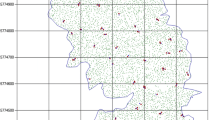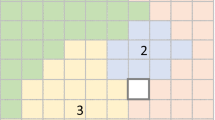Abstract
The Bitterlich relascope is a multiple use dendrometer widely used in forest inventory. Although it is most commonly used to estimate basal area, the relascope can also estimate other stand variables, including density and diameter distribution. However, forest stand inventories in Spain rarely use relascope plots to estimate these variables due to the belief that they lead to higher errors than fixed-radius plots due to the heterogeneity of many Mediterranean forests. This study compared the accuracy of the estimated averages of three main stand variables (basal area, stand density, and diameter class distribution) in forest stand inventories performed with relascope plots and with conventional fixed-radius circular plots, both measuring a similar number of trees (15–20). A forest stand inventory simulator (DOMO) was used (1) to generate simulated forest stands corresponding to the nine most common types in the Mediterranean region of Catalonia (NE Spain), including even-aged and uneven-aged stands, and (2) to estimate and compare the average values of these variables at the forest stand level resulting from both plot types. In general, we did not find significant accuracy differences between the inventory systems for most of the stand variables and forest types studied, as expected by established angle-count sampling theory. However, the results show that for stands with multiple strata and open structures, the Bitterlich relascope provides a more accurate estimate for basal area than for density, while the reverse occurs for fixed-radius plots.

Similar content being viewed by others
References
Avery TE, Burkhart HE (2002) Forest measurements, 5th edn. McGraw-Hill, New York, p 456
Bitterlich W (1984) The relascope idea. Relative measurements in forestry. Commonwealth Agricultural Bureau, Slough, p 242
Bleher B, Oberrath R, Bohning-Gaese K (2002) Seed dispersal, breeding system, tree density and the spatial pattern of trees—a simulation approach. Basic Appl Ecol 3(2):115–123
Bonnor GM, Magnussen S (1987) Forest inventories in Canada: a framework for change. For Chron 63:193–198
Burkhart HE (2008) Remembering Walter Bitterlich. J For 106(2):61
Burriel JA, Gracia C, Ibàñez JJ, Mata T, Vayreda J (2000–2004) Inventari Ecològic i Forestal de Catalunya. CREAF, Bellaterra
Cervera T, Farriol R, Muñoz A, Rabascall X (eds) (2004) Manual de redacció de Plans Tècnics de Gestió i Millora Forestal (PTGMF) i Plans Simples de Gestió Forestal (PSGF). Instruccions de redacció i l’inventari forestal. Generalitat de Catalunya. DMAH. CPF, Barcelona, España, p 316
Condés S, Martínez-Millán J (2005) DOMO: Una aplicación informática para el diseño de inventarios forestales. Actas I Reunión de Inventario y Teledetección Forestal. Cuadernos de la SECF 19:57–61
Diéguez U, Barrio M, Castedo F, Ruíz AD, Álvarez MF, Alvárez JG, Rojo A (2003) Dendrometría. Fundación Conde del Valle de Salazar E.T.S.I. Montes y Ediciones Mundi Prensa. p 327
Ducey MJ (1999) What expansion factor should be used in binned probability proportional to size sampling? Can J For Res 29:1290–1294
Fountain MS, Hunt EV, Hassler CC (1983) Comparison of five metric basal area factors. J For 81(1):26–27
Grenier Y, Du Sablon M (1993) Comparaison entre des prismes de différents facteurs de surface terrière pour établir la structure des diamètres d’un peuplement inéquienne. For Chron 69(2):193–197
Grenier Y, Blais L, Lavoie E (1991) Aire minimum d’échantillonnage ou nombre de points de prisme nécessaires pour établir la structure d’un peuplement inéquienne. Can J For Res 21(11):1632–1638
Grosenbaugh LR (1952) Plotless timber estimates-new, fast, easy. J For 50:32–37
Grosenbaugh LR (1958) Point-sampling and line-sampling: probability theory, geometric implications, synthesis. U. S. For. Serv. South. For. Exp. Stn. Occas. p 160
Grosenbaugh LR, Stover WS (1957) Point-sampling compared with plot-sampling in southeast Texas. For Sci 3:2–14
Hebert J, Rondeux J, Laurent C (1988) Comparaison par simulation de 3 types d’unités d’échantillonnage en futaies feuillues de hêtre (Fagus sylvatica L.). Ann Sci For 45(3):209–221
Humphries HC, Bourgeron PS, Mujica-Crapanzano LR (2008) Tree spatial patterns and environmental relationships in the forest-alpine tundra ecotone at Niwot Ridge, Colorado, USA. Ecol Res 23(3):589–605
Husch B, Miller CI, Beers TW (1982) Forest mensuration. Wiley, New York, p 402
Lecomte H, Hébert J, Rondeux J (1994) Comparaison de plusieurs types d’unités d’échantillonnage dans la perspective d’un inventaire forestier régional. For Chron 70(3):304–310
Lee C, Wensel JL, Klaus B (1980) Selection of basal area factor in point sampling. J For 78(2):83–84
Lowell KE (1997) An empirical evaluation of spatially based forest inventory samples. Can J For Res 27:352–360
Matérn B (1972) The precision of basal area estimates. For Sci 18:123–125
Moscovich FA, Brena DA, Longhi SJ (1999) Comparaçâo de diferentes métodos de amostragem, de área fixa e variável, em uma floresta de Araucaria angustifolia. Ciência Florestal 9(1):173–191
Oderwald RF (1981) Comparison of point and plot sampling basal area estimators. For Sci 27:42–48
Oliver CD, Larson BC (1996) Forest stand dynamics. Update edition. Wiley, New York, p 520
Overton WS, Stehman SV (1995) The Horvitz-Thompson theorem as an unifying perspective for probability sampling: with examples from natural resource sampling. Am Stat 49(3):261–268
Packard KC, Radtke PJ (2007) Forest sampling combining fixed and variable-radius sample plots. Can J For Res 37(8):1460–1471
Palley MN, Horwitz LG (1961) Properties of some random and systematic point sampling estimators. For Sci 7:52–65
Ríos N, Acosta V, Gaillard de Benítez C, Pece M (2000) Comparación entre métodos de muestreo. Invest Agr Sist Recur For 9(1):45–57
Rozas V (2006) Structural heterogeneity and tree spatial patterns in an old-growth deciduous lowland forest in Cantabria, northern Spain. Plant Ecol 185(1):57–72
Rubin BD, Manion PD, Faber-Langendoen D (2006) Diameter distributions and structural sustainability in forests. For Ecol Manag 222:427–438
Stage AR, Ledermann T (2008) Effects of competitor spacing in a new class of individual-tree indices of competition: semi-distance-independent indices computed for Bitterlich versus fixed-area plots. Can J For Res 38(4):890–898
Stenberg P, Korhonen L, Rautiainen M (2008) A relascope for measuring canopy cover. Can J For Res 38(9):2545–2550
Zeide B (1984) Distance to point-sampled trees and their diametres. For Ecol Manage 11:131–137
Acknowledgments
This study was supported by the Centre de la Propietat Forestal of Departament de Medi Ambient i Habitatge de la Generalitat de Catalunya. Authors wish to express their gratitude to Jaime Coello who collaborated in the language revision and the anonymous reviewers who provided useful remarks and suggestions to the manuscript.
Author information
Authors and Affiliations
Corresponding author
Additional information
Communicated by U. Berger.
Rights and permissions
About this article
Cite this article
Piqué, M., Obon, B., Condés, S. et al. Comparison of relascope and fixed-radius plots for the estimation of forest stand variables in northeast Spain: an inventory simulation approach. Eur J Forest Res 130, 851–859 (2011). https://doi.org/10.1007/s10342-010-0477-x
Received:
Revised:
Accepted:
Published:
Issue Date:
DOI: https://doi.org/10.1007/s10342-010-0477-x




